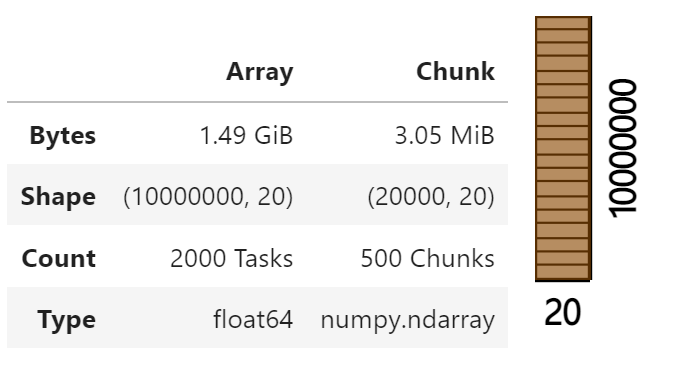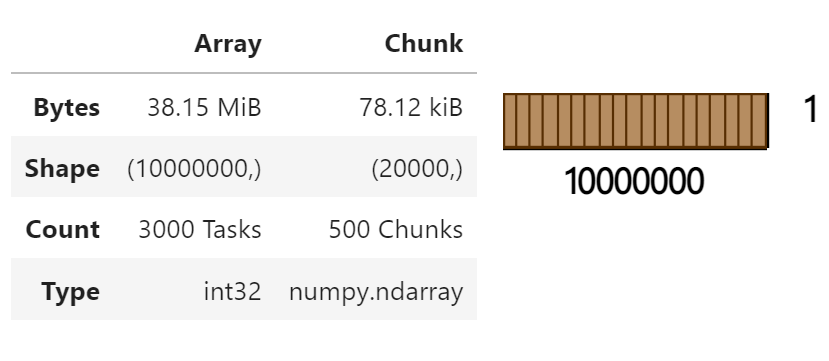Dask教程:并行和分布式机器学习
本文翻译自 dask-tutorial 项目
Dask-ML 包含用于并行和分布式机器学习的资源。
伸缩类型
Types of scaling
您可能会面临几个明显的伸缩问题。 伸缩策略取决于您面临的问题。
- CPU-Bound:数据适合 RAM,但训练时间太长。许多超参数组合,许多模型的大型集成等。
- 内存限制:数据大于 RAM,并且采样不是一种选择。

- 对于 in-memory 问题,只需使用 scikit-learn (或您最喜欢的 ML 库)。
- 对于大型模型,请使用
dask_ml.joblib和您最喜欢的 scikit-learn estimator - 对于大型数据集,使用
dask_mlestimator
5 分钟“学会” Scikit-Learn
Scikit-Learn 有很好的、一致的 API。
- 实例化一个
Estimator(例如LinearRegression、RandomForestClassifier等)。 所有模型 超参数 (用户指定的参数,不是估计器学习的参数) 在创建时都会传递给估计器。 - 调用
estimator.fit(X, y)来训练估计器。 - 使用
estimator检查属性、进行预测等。
让我们生成一些随机数据。
from sklearn.datasets import make_classification
X, y = make_classification(
n_samples=1000,
n_features=4,
random_state=0
)
X[:8]
array([[ 1.27815198, -0.41644753, 0.89181112, 0.77129444],
[ 1.35681817, -1.51465569, 1.82132242, 0.42081175],
[ 1.53341056, 2.06290707, -1.01967188, 1.87609016],
[ 0.42064934, 0.05455201, 0.13725671, 0.32493018],
[-0.88825673, -1.10088618, 0.51393811, -1.05185003],
[ 0.26413558, -0.42774504, 0.46291997, 0.0326177 ],
[-1.15189334, -1.43613997, 0.6734141 , -1.36719829],
[ 0.85289242, -0.74009387, 0.97199307, 0.34318408]])
y[:8]
array([1, 1, 1, 1, 0, 1, 0, 1])
我们训练一个支持向量机分类器
from sklearn.svm import SVC
创建估计器并训练
estimator = SVC(random_state=0)
estimator.fit(X, y)
SVC(random_state=0)
estimator.support_vectors_[:4]
array([[-0.42055907, 1.40271694, -1.32553426, 0.21581905],
[-0.34484432, 1.48991186, -1.36392417, 0.30301324],
[-0.63718703, 0.26016267, -0.48744254, -0.36500832],
[-0.67132345, -0.93017037, 0.46845503, -0.83137829]])
检查准确率
estimator.score(X, y)
0.96
超参数
大多数模型有 超参数 (hyperparameter)。 它们会影响拟合,但会预先指定,而不是在训练期间学习。
estimator = SVC(
C=0.00001,
shrinking=False,
random_state=0
)
estimator.fit(X, y)
estimator.support_vectors_[:4]
array([[-0.88825673, -1.10088618, 0.51393811, -1.05185003],
[-1.15189334, -1.43613997, 0.6734141 , -1.36719829],
[-1.5733362 , 0.21321628, -0.85362176, -1.06050993],
[-2.549207 , -0.72557246, -0.50971799, -2.11567941]])
estimator.score(X, y)
0.502
超参数优化
有几种方法可以在训练时学习最佳 超参数。
一种是 GridSearchCV。
顾名思义,这会在超参数组合的网格上进行暴力搜索。
from sklearn.model_selection import GridSearchCV
%%time
estimator = SVC(
gamma="auto",
random_state=0,
probability=True
)
param_grid = {
"C": [0.001, 10.0],
"kernel": ["rbf", "poly"]
}
grid_search = GridSearchCV(
estimator,
param_grid,
verbose=2,
cv=2
)
grid_search.fit(X, y)
Fitting 2 folds for each of 4 candidates, totalling 8 fits
[CV] END ................................C=0.001, kernel=rbf; total time= 0.0s
[CV] END ................................C=0.001, kernel=rbf; total time= 0.0s
[CV] END ...............................C=0.001, kernel=poly; total time= 0.0s
[CV] END ...............................C=0.001, kernel=poly; total time= 0.0s
[CV] END .................................C=10.0, kernel=rbf; total time= 0.0s
[CV] END .................................C=10.0, kernel=rbf; total time= 0.0s
[CV] END ................................C=10.0, kernel=poly; total time= 0.0s
[CV] END ................................C=10.0, kernel=poly; total time= 0.0s
Wall time: 448 ms
GridSearchCV(cv=2,
estimator=SVC(gamma='auto', probability=True, random_state=0),
param_grid={'C': [0.001, 10.0], 'kernel': ['rbf', 'poly']},
verbose=2)
使用 scikit-learn 实现单机并行

Scikit-Learn 通过 Joblib 具有很好的 单机 (single-machine) 并行性。
任何可以并行操作的 scikit-learn 估计器都会公开一个 n_jobs 关键字,控制将使用的 CPU 内核数。
%%time
grid_search = GridSearchCV(
estimator,
param_grid,
verbose=2,
cv=2,
n_jobs=-1
)
grid_search.fit(X, y)
使用 Dask 实现多机并行

Dask 可以与 scikit-learn (通过 joblib) 通信,以便您的 集群 用于训练模型。
如果您在笔记本电脑上运行,将需要相当长的时间,但 CPU 使用率在此期间将令人满意地接近 100%。
要运行得更快,您需要一个分布式集群。
这意味着在对 Client 的调用中放入一些类似的东西
c = Client("tcp://my.scheduler.address:8786")
可以在此处找到有关创建集群的多种方法的详细信息。
让我们在更大的问题 (更多超参数) 上尝试一下。
import joblib
import dask.distributed
c = dask.distributed.Client()
c

param_grid = {
"C": [0.001, 0.1, 1.0, 2.5, 10.0],
# 取消注释此以在集群上进行更大的网格搜索
# "kernel": ["rbf", "poly", "linear"],
# "shrinking": [True, False],
}
grid_search = GridSearchCV(
estimator,
param_grid,
verbose=2,
cv=5,
n_jobs=-1
)
%%time
with joblib.parallel_backend("dask", scatter=[X, y]):
grid_search.fit(X, y)
Fitting 5 folds for each of 5 candidates, totalling 25 fits
Wall time: 3.26 s
grid_search.best_params_, grid_search.best_score_
({'C': 2.5}, 0.9629999999999999)
在大型数据集上训练
有时您会想要在比内存更大的数据集上进行训练。
dask-ml 已经实现了估算器,可以很好地处理可能大于机器 RAM 的 dask 数组和数据帧。
import dask.array as da
import dask.delayed
from sklearn.datasets import make_blobs
import numpy as np
我们将使用 scikit-learn 在本地创建一个小型 (随机) 数据集。
n_centers = 12
n_features = 20
X_small, y_small = make_blobs(
n_samples=1000,
centers=n_centers,
n_features=n_features,
random_state=0
)
centers = np.zeros((n_centers, n_features))
for i in range(n_centers):
centers[i] = X_small[y_small == i].mean(0)
centers[:4]
array([[ 1.00796679, 4.34582168, 2.15175661, 1.04337835, -1.82115164,
2.81149666, -1.18757701, 7.74628882, 9.36761449, -2.20570731,
5.71142324, 0.41084221, 1.34168817, 8.4568751 , -8.59042755,
-8.35194302, -9.55383028, 6.68605157, 5.34481483, 7.35044606],
[ 9.49283024, 6.1422784 , -0.97484846, 5.8604399 , -7.61126963,
2.86555735, -7.25390288, 8.89609285, 0.33510318, -1.79181328,
-4.66192239, 5.43323887, -0.86162507, 1.3705568 , -9.7904172 ,
2.3613231 , 2.20516237, 2.20604823, 8.76464833, 3.47795068],
[-2.67206588, -1.30103177, 3.98418492, -8.88040428, 3.27735964,
3.51616445, -5.81395151, -7.42287114, -3.73476887, -2.89520363,
1.49435043, -1.35811028, 9.91250767, -7.86133474, -5.78975793,
-6.54897163, 3.08083281, -5.18975209, -0.85563107, -5.06615534],
[-6.85980599, -7.87144648, 3.33572279, -7.00394241, -5.97224874,
-2.55638942, 6.36329802, -7.97988653, 6.80059611, -8.14552537,
9.48255539, -0.67232114, 9.38462699, 2.09067352, 4.80505419,
-9.14866204, -4.32240399, -7.61670696, -4.14166466, -7.73998277]])
小数据集将成为我们大型随机数据集的模板。
我们将使用 dask.delayed 来应用 sklearn.datasets.make_blobs,以便在我们的工作负载上生成实际的数据集。
n_samples_per_block = 20000
n_blocks = 500
delayeds = [
dask.delayed(make_blobs)(
n_samples=n_samples_per_block,
centers=centers,
n_features=n_features,
random_state=i
)[0] for i in range(n_blocks)
]
arrays = [
da.from_delayed(
obj,
shape=(n_samples_per_block, n_features),
dtype=X.dtype
) for obj in delayeds
]
X = da.concatenate(arrays)
X

X = X.persist() # 只在集群上运行
Dask-ML 中实现的算法是可扩展的。 它们可以很好地处理大于内存的数据集。
它们遵循 scikit-learn API,因此如果您熟悉 scikit-learn,您会对 Dask-ML 感到宾至如归。
from dask_ml.cluster import KMeans
clf = KMeans(
init_max_iter=3,
oversampling_factor=10
)
%time clf.fit(X)
Wall time: 49.1 s
KMeans(init_max_iter=3, oversampling_factor=10)
clf.labels_

clf.labels_[:10].compute()
array([7, 4, 7, 5, 4, 2, 1, 7, 6, 7])
结束
client.close()
参考
Dask 教程
